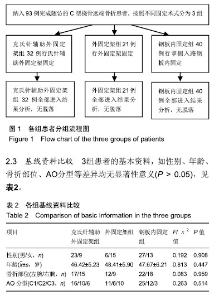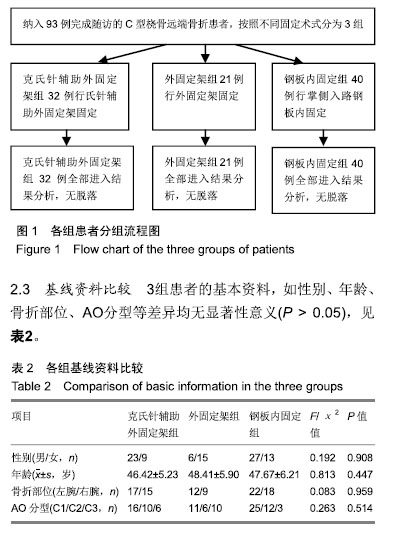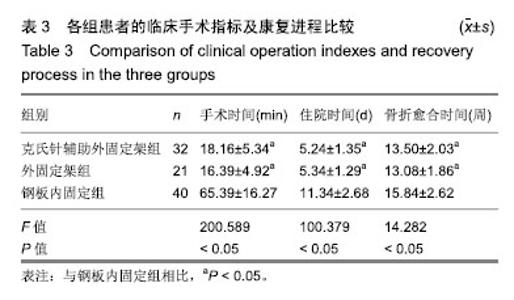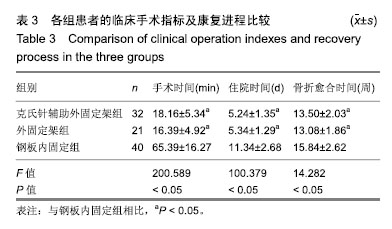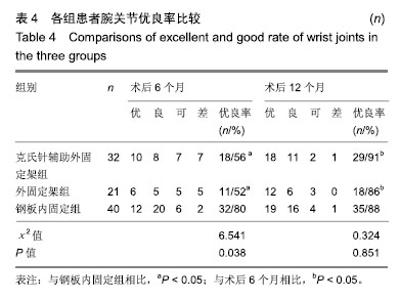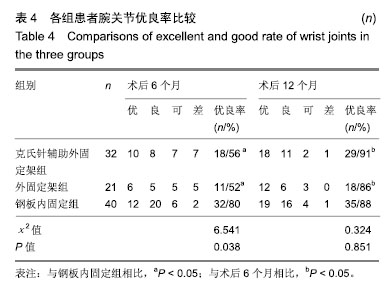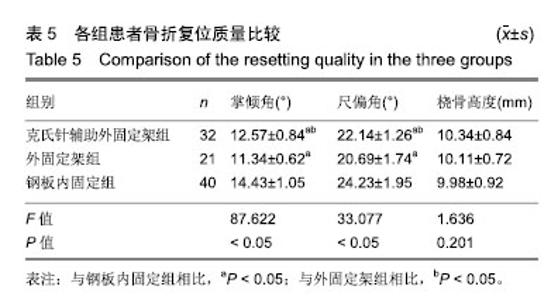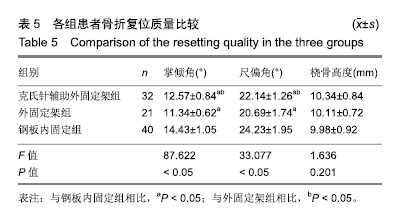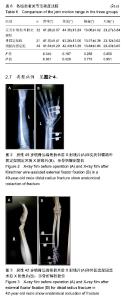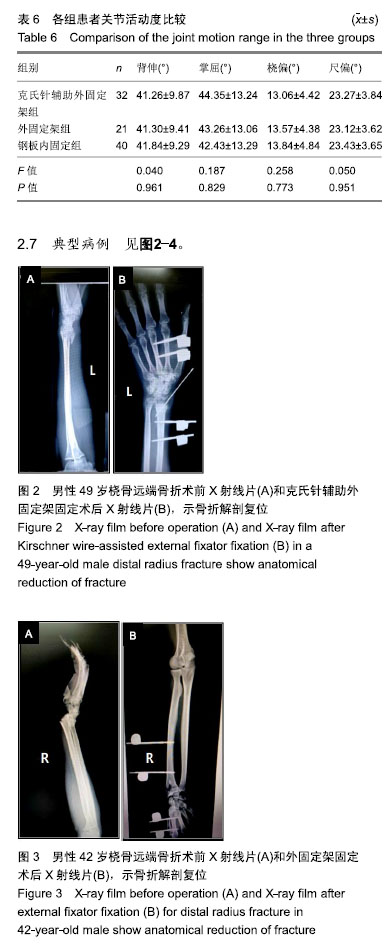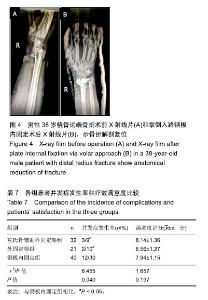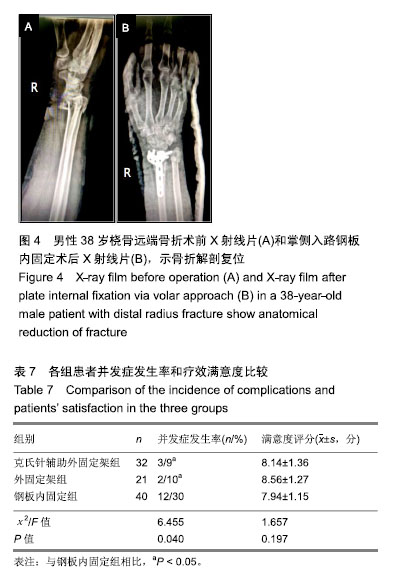Chinese Journal of Tissue Engineering Research ›› 2019, Vol. 23 ›› Issue (32): 5126-5132.doi: 10.3969/j.issn.2095-4344.1981
Previous Articles Next Articles
Wrist join function and resetting quality of type C distal radius fractures patients: a comparison of Kirschner wire external fixator, external fixator and volar approach plate internal fixation
Zhuo Jin, Wang Shasha, Chen Qiqiang, Cao Xianchang, Zhang Zhongwei
- Department of Rehabilitation Therapy, Hainan Provincial People’s Hospital, Haikou 570311, Hainan Province, China
-
Online:2019-11-18Published:2019-11-18 -
About author:Zhuo Jin, Chief technician, Department of Rehabilitation Therapy, Hainan Provincial People’s Hospital, Haikou 570311, Hainan Province, China -
Supported by:the General Medical Research Project of the Committee on Health and Family Planning of Hainan Province, No. 20140053 (to ZJ)
CLC Number:
Cite this article
Zhuo Jin, Wang Shasha, Chen Qiqiang, Cao Xianchang, Zhang Zhongwei. Wrist join function and resetting quality of type C distal radius fractures patients: a comparison of Kirschner wire external fixator, external fixator and volar approach plate internal fixation[J]. Chinese Journal of Tissue Engineering Research, 2019, 23(32): 5126-5132.
share this article
| [1]张勇,阿良,张乐,等.固定方式对C型桡骨远端骨折术后长度维持的影响[J].中国医科大学学报,2016,45(3):246-248,254. [2]Heidgerd R, Morgan J, Schentrup D. Evaluation of functional outcomes for adult patients after distal radius fracture treated with volar plate fixation versus nonsurgical care. J Trauma Nurs. 2019;26(1): 59-64. [3]吴文侠,李建林,李铁军,等.万向锁定加压钢板与克氏针结合外固定支架对老年绝经期骨质疏松性桡骨远端C型骨折短缩程度及关节功能的影响[J].医学临床研究,2015,32(3):549-551. [4]Bartl C, Stengel D, Bruckner T, et al. The treatment of displaced intra-articular distal radius fractures in elderly patients. Dtsch Arztebl Int. 2014; 111(46): 779-787. [5]Lang PO, Bickel KD. Distal radius fractures: percutaneous treatment versus open reduction with internal fixation. J Hand Surg Am. 2014;39(3): 546-548.[6]胥少汀.实用骨科学[M]. 4版. 北京:人民军医出版社, 2012: 316-318.[7]刘长发,汪少春,姚亮,等.克氏针辅助外固定架与掌侧入路钢板内固定治疗AOC型桡骨远端骨折的疗效比较[J].中国骨与关节损伤杂志,2016,31(7): 770-771. [8]张胜华.克氏针加强外固定架与锁定加压钢板治疗桡骨远端C3型骨折的对比性研究[J].中国煤炭工业医学杂志,2016,19(6): 856-859.[9]Guo W, Yuan B, Zhu Z, et al. Non-dislocation lunate fracture combined with distal radius fracture: A case report. Medicine (Baltimore). 2018;97(49): e13574. [10]蔡振存,赵群,张立军.外固定架结合有限克氏针微创治疗桡骨远端C型骨折的临床研究[J].中国医科大学学报,2014,43(12): 1145-1146. [11]姜新华,禹宝庆,王永安,等.掌侧柱锁定接骨板治疗桡骨远端C型骨折的疗效分析[J]. 中华骨与关节外科杂志,2015,8(2): 157-160. [12]Ibrahim T, OMS A, Hegazy A, et al. Applicability of the AAOS appropriate-use criteria for distal radius fractures in surgical practice. Int Orthop. 2018; 42(1): 197-202. [13]Kyriakedes JC, Tsai EY, Weinberg DS, et al. Distal radius fractures: aaos appropriate use criteria versus actual management at a level i trauma center. Hand (NY). 2018;13(2): 209-214. [14]王古衡, 谢仁国, 茅天, 等. C型桡骨远端骨折掌侧内固定中接骨板不同位置对疗效影响[J]. 中华手外科杂志, 2016, 32(2): 116-119. [15]富玲,辛畅泰,王英博,等.桡骨远端C型骨折行外固定支架与锁定钢板内固定的差异分析[J].现代生物医学进展,2017,17(33): 6531-6535.[16]朱成栋,朱乐银,乔高山,等. 跨腕关节外固定支架配合克氏针治疗桡骨远端C型骨折的疗效分析[J]. 生物骨科材料与临床研究, 2015,12(1): 55-58. [17]王松,刘孟军,杨青山,等.克氏针与钢板置入内固定修复老年桡骨远端骨折安全及有效性的Meta分析[J].中国组织工程研究, 2016, 20(9):1361-1368. [18]Duramaz A, Bilgili MG, Karaali E, et al. Volar locking plate versus K-wire-supported external fixation in the treatment of AO/ASIF type C distal radius fractures: A comparison of functional and radiological outcomes. Ulus Travma Acil Cerrahi Derg. 2018;24(3): 255-262. [19]赵继军,吴沼锋,王陵,等.桡骨远端T型锁定接骨板治疗老年桡骨远端不稳定性骨折的疗效[J].中国老年学杂志,2015,35(22): 6584-6585.[20]蔺广生.经皮克氏针内固定与掌锁定钢板内固定治疗成人桡骨远端背侧移位骨折临床疗效比较[J].临床和实验医学杂志,2016, 15(17): 1708-1711. [21]王东建,张鑫,张延栋.克氏针经皮固定治疗桡骨远端骨折[J].临床骨科杂志,2017,20(1):80-81. [22]蔡浩.克氏针外固定结合钢板内固定治疗桡骨远端粉碎性骨折的疗效分析[J]. 中国伤残医学,2018,26(2):45-46. [23]王涛,刘剑,张文生,等.克氏针结合可调式外固定架治疗桡骨远端骨折32例[J]. 陕西医学杂志,2014,43(1):90-91, 92.[24]王荣林,肖毅.锁定加压钢板+经皮克氏针治疗桡骨远端粉碎性骨折的疗效[J].实用中西医结合临床,2018,18(4):137-138. [25]Wang J, Lu Y, Cui Y, et al. Is volar locking plate superior to external fixation for distal radius fractures? A comprehensive meta-analysis. Acta Orthop Traumatol Turc. 2018; 52(5): 334-342. [26]朱乘春.掌侧入路切开复位钢板内固定与闭合复位外固定支架治疗桡骨远端骨折患者的效果[J].医疗装备,2018,31(12): 117-118. [27]张树峰,叶武智,高长城,等.切开复位钢板内固定与闭合复位外支架固定治疗老年桡骨远端C型骨折疗效比较[J].陕西医学杂志, 2015,44(11):1504-1505. [28]余荣煌,林石明.闭合复位外支架结合克氏针治疗桡骨远端不稳定性骨折的临床研究[J].医药前沿,2015,5(31):160-161. [29]李家德,钟永翔,陈榆,等.外固定架结合克氏针有限固定与掌侧锁定板治疗桡骨远端粉碎骨折的疗效对比[J].中华手外科杂志, 2018,34(3):185-188.[30]桑庆华,张世虎,姜佩瑜,等. 外固定架联合克氏针撬拨复位固定在治疗桡骨远端复杂关节内骨折的应用研究[J]. 浙江临床医学, 2018, 20(8): 1421-1423. [31]郑一舟,李唯.掌侧锁定钢板加横向克氏针内固定治疗桡尺远侧关节失稳型桡骨远端骨折[J].中华手外科杂志,2014,30(5): 327-329. [32]朱成栋,朱乐银,乔高山,等.两种手术方式结合植骨治疗桡骨远端C型骨折的疗效对比研究[J].实用骨科杂志,2016,22(1): 55-58. [33]Yuan ZZ, Yang Z, Liu Q, et al. Complications following open reduction and internal fixation versus external fixation in treating unstable distal radius fractures: Grading the evidence through a meta-analysis. Orthop Traumatol Surg Res. 2018; 104(1): 95-103. [34]Tarallo L, Mugnai R, Zambianchi F, et al. Volar plate fixation for the treatment of distal radius fractures: analysis of adverse events. J Orthop Trauma. 2013;27(12): 740-745.[35]Johnson NA, Cutler L, Dias JJ, et al. Complications after volar locking plate fixation of distal radius fractures. Injury. 2014; 45(3):528-533. [36]Wichlas F, Haas NP, Disch A, et al. Complication rates and reduction potential of palmar versus dorsal locking plate osteosynthesis for the treatment of distal radius fractures. J Orthop Traumatol. 2014;15(4): 259-264. [37]Jeudy J, Steiger V, Boyer P, et al. Treatment of complex fractures of the distal radius: a prospective randomised comparison of external fixation 'versus' locked volar plating. Injury. 2012;43(2): 174-179.[38]Estrella EP, Panti PL. Outcome of unstable distal radius fractures treated with open reduction and internal fixation versus external fixation. Hand Surg. 2012; 17(2): 173-179.[39]Kumbaraci M, Kucuk L, Karapinar L, et al. Retrospective comparison of external fixation versus volar locking plate in the treatment of unstable intra-articular distal radius fractures. Eur J Orthop Surg Traumatol. 2014;24(2): 173-178.[40]Greeven AP, Bezstarosti S, Krijnen P, et al. Open reduction and internal fixation versus percutaneous transverse Kirschner wire fixation for single, closed second to fifth metacarpal shaft fractures: a systematic review. Eur J Trauma Emerg Surg. 2016;42(2): 169-175. |
| [1] | Wu Shengxiang, Liu Yuan, Lu Shuai. Mini-locking titanium plate system fixation in the treatment of carpal scaphoid fracture [J]. Chinese Journal of Tissue Engineering Research, 2021, 25(12): 1874-1878. |
| [2] | Wang Min, Ma Wenze, Li Wencheng, Liang Cai, Wang Jinhui. A comparative study of mini-locking plate and external fixator in the treatment of comminuted cuboid fracture [J]. Chinese Journal of Tissue Engineering Research, 2020, 24(6): 843-849. |
| [3] | Chen Xiaojun, Luo Tao, Ou Changliang, He Zhiyu, Zhou Xin, Tang Xincheng, Mo Deping, Zou Yonggen. Comparison of external fixator-assisted reduction and locking plate internal fixation and simple locking plate internal fixation in the treatment of type C distal radius fractures [J]. Chinese Journal of Tissue Engineering Research, 2020, 24(33): 5315-5320. |
| [4] | Zhang Yan, Shen Zhen, Li Zige, Huang Minling, Feng Junming, Xie Lei, Gao Yijia, Zeng Zhanpeng, Jiang Ziwei. Establishing a rat model of atrophic nonunion by using circular external fixator combined with periosteum cauterization [J]. Chinese Journal of Tissue Engineering Research, 2020, 24(29): 4650-4655. |
| [5] | Hu Xiangyu, Su Peng, Zhang Li, Li Jian, Qin Sihe, Fan Yubo. Transmission efficiency of Ilizarov external fixator orthopedic force based on coordinate transformation theory [J]. Chinese Journal of Tissue Engineering Research, 2020, 24(21): 3287-3292. |
| [6] | Chen Yanming, Liu Mingjiang, Xie Songlin, Liu Changxiong, Song Jiangang. Skin flap transplantation combined with membrane induction technique for repair of long bone defects and soft tissue defects [J]. Chinese Journal of Tissue Engineering Research, 2020, 24(16): 2551-2555. |
| [7] | Ke Wei, Li Ke, Wang Sibo, Du Xinhui, Qiu Zhongpeng, Kang Zhilin, Wang Weishan, Li Gang . Open reduction and plate fixation versus closed reduction and external fixation for distal radius fractures: scores and linear regression analysis [J]. Chinese Journal of Tissue Engineering Research, 2019, 23(8): 1196-1202. |
| [8] | Li Hongyuan, Wang Liang. Comparison of the effect and stability of rigid or flexible external fixator in inducing healing tissue formation at fracture site in mice [J]. Chinese Journal of Tissue Engineering Research, 2019, 23(28): 4510-4515. |
| [9] | Liu Yao, Huang Yue, Liu Yong, Luo Yuru, Luo Jing, Ju Mei . Biomechanical stability of three-dimensional external fixator applied in early-stage senile osteoporotic fracture [J]. Chinese Journal of Tissue Engineering Research, 2018, 22(35): 5602-5606. |
| [10] | Hu Panyong, Yang Shaoan, Cai Baota, Cao Jun, Yang Xiao. Efficacy of adjustable external support versus hinged external fixator in the treatment of terrible triad of elbow [J]. Chinese Journal of Tissue Engineering Research, 2018, 22(35): 5607-5613. |
| [11] | Feng Zhen1, Zhang Meng2, Wu Wei-na3. “Accordion” technology treats nonunion in model rabbits [J]. Chinese Journal of Tissue Engineering Research, 2018, 22(32): 5175-5179. |
| [12] | Gao Wei-xu, Chen Xiao, Wang Qiang. Treatment outcomes of casting versus plate for distal radius fracture in adults: a meta-analysis [J]. Chinese Journal of Tissue Engineering Research, 2018, 22(31): 5069-5076. |
| [13] | Yan Wei, Kong Bo, Jiang Tao, Jia You-ji1, Xi Xiao-bing . Clinical verification and improved design of the new traction splint for distal radius fractures [J]. Chinese Journal of Tissue Engineering Research, 2018, 22(27): 4294-4299. |
| [14] | Li Kai, Tan Qi, Zhang Tao, Hou Shu-jun, Liu Yan-shi, Zhang Xing-peng. Axial loading to predict the posture deviation of the tibial fragment elongated with Ilizarov external fixation [J]. Chinese Journal of Tissue Engineering Research, 2018, 22(23): 3675-3680. |
| [15] | Zhang Peng, Bi Zheng-gang. Distal femoral fractures: Fixation and individualized treatment [J]. Chinese Journal of Tissue Engineering Research, 2018, 22(23): 3723-3729. |
| Viewed | ||||||
|
Full text |
|
|||||
|
Abstract |
|
|||||
